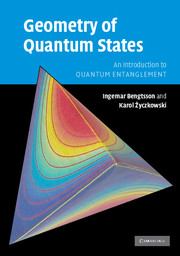Book contents
- Frontmatter
- Contents
- Preface
- 1 Convexity, colours and statistics
- 2 Geometry of probability distributions
- 3 Much ado about spheres
- 4 Complex projective spaces
- 5 Outline of quantum mechanics
- 6 Coherent states and group actions
- 7 The stellar representation
- 8 The space of density matrices
- 9 Purification of mixed quantum states
- 10 Quantum operations
- 11 Duality: maps versus states
- 12 Density matrices and entropies
- 13 Distinguishability measures
- 14 Monotone metrics and measures
- 15 Quantum entanglement
- Epilogue
- Appendix 1 Basic notions of differential geometry
- Appendix 2 Basic notions of group theory
- Appendix 3 Geometry: do it yourself
- Appendix 4 Hints and answers to the exercises
- References
- Index
2 - Geometry of probability distributions
Published online by Cambridge University Press: 27 August 2009
- Frontmatter
- Contents
- Preface
- 1 Convexity, colours and statistics
- 2 Geometry of probability distributions
- 3 Much ado about spheres
- 4 Complex projective spaces
- 5 Outline of quantum mechanics
- 6 Coherent states and group actions
- 7 The stellar representation
- 8 The space of density matrices
- 9 Purification of mixed quantum states
- 10 Quantum operations
- 11 Duality: maps versus states
- 12 Density matrices and entropies
- 13 Distinguishability measures
- 14 Monotone metrics and measures
- 15 Quantum entanglement
- Epilogue
- Appendix 1 Basic notions of differential geometry
- Appendix 2 Basic notions of group theory
- Appendix 3 Geometry: do it yourself
- Appendix 4 Hints and answers to the exercises
- References
- Index
Summary
Some people hate the very name of statistics, but I find them full of beauty and interest.
Sir Francis GaltonIn quantum mechanics one often encounters sets of non-negative numbers that sum to unity, having a more or less direct interpretation as probabilities. This includes the squared moduli of the coefficients when a pure state is expanded in an orthonormal basis, the eigenvalues of density matrices, and more. Continuous distributions also play a role, even when the Hilbert space is finite dimensional. From a purely mathematical point of view a probability distribution is simply a measure on a sample space, constrained so that the total measure is one. Whatever the point of view one takes on this, the space of states will turn into a convex set when we allow probabilistic mixtures of its pure states. In classical mechanics the sample space is phase space, which is typically a continuous space. This leads to technical complications but the space of states in classical mechanics does share a major simplifying feature with the discrete case, namely that every state can be expressed as a mixture of pure states in a unique way. This was not so in the case of colour space, nor will it be true for the convex set of all states in quantum mechanics.
Majorization and partial order
Our first aim is to find ways of describing probability distributions; we want to be able to tell when a probability distribution is ‘more chaotic’ or ‘more uniform’ than another. One way of doing this is provided by the theory of majorization.
- Type
- Chapter
- Information
- Geometry of Quantum StatesAn Introduction to Quantum Entanglement, pp. 28 - 61Publisher: Cambridge University PressPrint publication year: 2006



